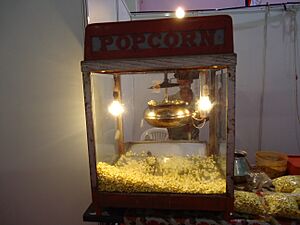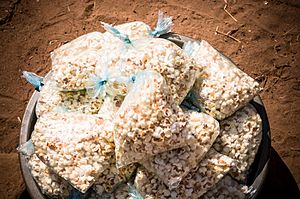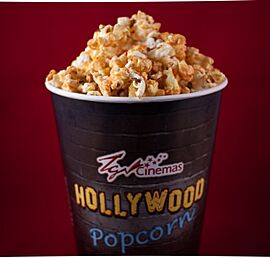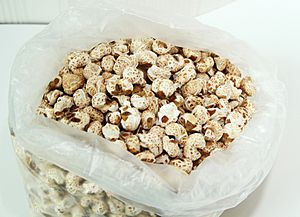Popcorn facts for kids
Quick facts for kids Popcorn |
|
|---|---|
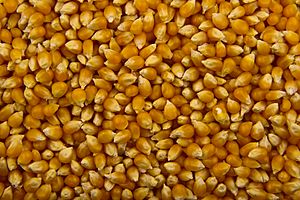 |
|
| Unpopped corn | |
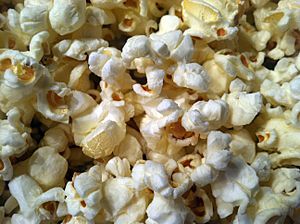 |
|
| Popped corn | |
| Scientific classification | |
| Kingdom: | |
| (unranked): | |
| (unranked): | |
| (unranked): | |
| Order: | |
| Family: | |
| Genus: | |
| Species: | |
| Subspecies: |
Z. m. everta
|
| Trinomial name | |
| Zea mays everta |
|
Popcorn is a special type of corn kernel. When you heat it up, it expands and puffs into a tasty snack! The word "popcorn" can mean both the unpopped kernels and the yummy food they become.
Each popcorn kernel has a strong outer shell. Inside, there's a hard, starchy part called the endosperm, which holds a little bit of water. When the kernel gets hot, this water turns into steam. The steam builds up a lot of pressure inside the kernel. Eventually, the hull (outer shell) breaks open, and the kernel quickly expands. It can grow 20 to 50 times its original size! Then, it cools down and becomes the fluffy popcorn we love.
Not all corn can be popcorn. Special types of corn are grown just for popping. The most common type is called Zea mays everta, which is a kind of flint corn. Popcorn is one of six main types of corn. Other types include dent corn, flour corn, and sweet corn.
Contents
The Amazing History of Popcorn
Corn first grew in what is now Mexico about 10,000 years ago. People have known about popcorn for thousands of years! Scientists found proof of corn popping in Peru from over 1,000 years ago. The oldest clear evidence of popcorn comes from New Mexico, United States. It shows that people were popping corn as early as 3600 BCE. These early people, called the Ancestral Puebloans, traded with groups in Mexico.
In the 1800s, people popped corn by hand on stove tops. They sold kernels on the East Coast of the United States. The name "popped corn" first appeared in a dictionary in 1848. Popcorn was also an ingredient in Cracker Jack candy from its early days.
Popcorn became much easier to make in the 1890s. That's when Charles Cretors invented the popcorn maker. Charles Cretors owned a candy store in Chicago. He used steam-powered machines to roast nuts and then used the same idea for corn kernels.
By the early 1900s, Cretors had street carts with steam-powered popcorn makers. During the Great Depression, popcorn was very cheap, costing only 5–10 cents a bag. This made it super popular! While many businesses struggled, popcorn sales boomed. It even helped farmers earn money.
During World War II, sugar was rationed, so less candy was made. Americans ate three times more popcorn than before! Popcorn became a hit at movie theaters. At first, some theater owners didn't like it, thinking it was a distraction. But they soon changed their minds. In 1938, a theater owner named Glen W. Dickinson Sr. put popcorn machines in his lobbies. Popcorn made more money than movie tickets! This helped keep ticket prices low.
When television became popular in the 1940s, fewer people went to theaters. So, popcorn eating went down. But the Popcorn Institute, a group of popcorn makers, encouraged people to eat popcorn at home. This helped bring popcorn sales back up.
In 1970, the famous Orville Redenbacher's popcorn brand started. In 1981, General Mills got the first patent for a microwave oven popcorn bag. This made popcorn even more popular at home.
Many towns in the Midwestern United States claim to be the "Popcorn Capital of the World." These include Ridgway, Illinois, and Valparaiso, Indiana. Most popcorn corn is grown in Nebraska, Indiana, and Texas. Thanks to an elementary school project, popcorn is now the official state snack of Illinois!
How Popcorn Pops: The Science
Each popcorn kernel has water and oil inside. Unlike other grains, the outer shell of a popcorn kernel is very strong. It doesn't let moisture escape easily. The starch inside is also very hard.
When the oil and water inside the kernel get hot, they turn into steam. This steam makes the starch inside soft and jelly-like. The steam pressure keeps building up. It reaches about 135 pounds per square inch (psi) and a temperature of 356°F (180°C). That's when the hull breaks!
When the hull ruptures, the pressure inside drops suddenly. The steam quickly expands, turning the starch and proteins into a light, airy foam. As this foam cools down fast, it becomes the crispy, puffy popcorn we know.
Farmers grow special types of corn to get the best popping results. Even though some other corn types might pop a little, the best popcorn comes from Zea mays everta, a type of flint corn.
Ways to Cook Popcorn
You can cook popcorn with butter or oil. At home, you can pop small amounts in a pot on the stove. But for selling popcorn, people use special popcorn machines. Charles Cretors invented these machines in Chicago, Illinois, in 1885. He showed his invention at a big fair in 1893. At that same fair, F. W. Rueckheim introduced "Candied Popcorn," which was the first caramel corn. His brother later changed the recipe a bit and called it Cracker Jack in 1896.
Cretors' invention was the first machine that used steam to pop corn in oil. Before that, sellers held a wire basket over a flame. This often made the popcorn dry and unevenly cooked. Cretors' machine popped corn in a mix of butter, lard, and salt. This mix could handle the high heat needed to pop corn without much smoke. The steam engine also powered a small puppet called "The Toasty Roasty Man" to attract customers!
Another way to make popcorn uses a "popcorn hammer." This is a large cast-iron container with a heavy lid. It's slowly turned over a fire, like a rotisserie.
How Much Popcorn You Get
How well popcorn pops depends on how fast it's heated. If it heats too fast, the steam in the outer layers might break the hull before the center starch is ready. This leads to partially popped kernels with hard centers. If it heats too slowly, the steam can leak out of the kernel's tip. Then, the pressure won't build enough to make it pop at all.
People who grow and sell popcorn look at two main things: how many kernels pop, and how much each popped kernel expands. Expansion is important for both you and the seller. Bigger pieces of popcorn are usually softer and taste better. For sellers, bigger popcorn means more profit. They buy popcorn by weight but sell it by volume. So, popcorn that expands more earns them more money.
Freshly picked popcorn will pop, but not very well. It has too much water, which makes the popped corn chewy. Kernels with too much water can also get moldy when stored. So, popcorn growers dry the kernels until they have just the right amount of moisture. This is usually around 14–15% water by weight. If kernels are too dry, they won't expand as much, and fewer will pop. Old popcorn tends to dry out, which means you get less popped corn.
Sometimes, after popping, you'll find unpopped kernels. In the popcorn business, these are called "old maids." They didn't pop because they didn't have enough moisture to create enough steam for an explosion. If you add a little moisture back to them before popping, they usually pop.
Popcorn types are often grouped by the shape or color of their kernels, or the shape of the popped corn. Even though kernels come in many colors, the popped corn is always off-yellow or white. That's because only the outer hull is colored. "Rice" type popcorn kernels are long and pointed. "Pearl" type kernels are round. Most commercial popcorn today is the pearl type. Historically, pearl popcorn was yellow and rice popcorn was white. But now, you can find both shapes in yellow, white, black, red, purple, and even mixed colors! Purple popcorn often has smaller, nutty kernels. Most popcorn sold today is white or yellow.
Popcorn Words You Should Know
In the popcorn world, a popped kernel is called a "flake." There are two main shapes of flakes:
- "Butterfly" (or "snowflake") flakes have an irregular shape with many "wings" sticking out. They are often thought to taste better because they are more tender and the hull is less noticeable.
- "Mushroom" flakes are mostly ball-shaped with few wings. They are stronger than butterfly flakes. This makes them good for packaged popcorn or candies like caramel corn.
A single cob of popcorn can produce both butterfly and mushroom flakes. But there are special types of popcorn that produce 100% butterfly or 100% mushroom flakes. The way the popcorn is grown and popped can also change the mix of butterfly to mushroom flakes.
When you talk about many pieces of popcorn, you say "popcorn." But if you're talking about just one piece, you call it a "kernel."
Eating Popcorn
Popcorn is a very popular snack food at sports games and in movie theaters. It has been served in cinemas since the 1930s. Some people complain that movie theaters charge too much for popcorn!
In the United States, people usually eat popcorn as a salty snack. But in places like Germany, it's often eaten as a sweet snack with caramelized sugar.
Popcorn has a smell that humans find very attractive. This is because it contains special chemicals like 6-acetyl-2,3,4,5-tetrahydropyridine. These chemicals are very powerful and make popcorn smell so good. They are also used in other foods to make them smell like popcorn or bread.
In the 1800s, Americans even ate popcorn as a breakfast cereal! They would have it with milk and a sweetener.
Popcorn balls (popped kernels stuck together with sugary "glue") were very popular around the year 1900. Their popularity has gone down, but they are still a traditional Halloween treat in some places. Cracker Jack is a well-known candy with peanuts mixed into caramel-covered popcorn.
Kettle corn is another type of popcorn. It's cooked with white sugar and salt, often in a large copper kettle. It used to be found only at special shops or fairs. But now, kettle corn is very popular, especially in microwave popcorn bags. Home popcorn makers are also becoming more popular. They let you add your own flavors and make healthier popcorn.
Popped sorghum is a popular snack in India. It's like popcorn, but the puffs are smaller. You can find recipes online for popping sorghum in a microwave or a pot.
How Healthy is Popcorn?
| Nutritional value per 100 g (3.5 oz) | |
|---|---|
| Energy | 1,598 kJ (382 kcal) |
|
78 g
|
|
| Dietary fiber | 15 g |
|
4 g
|
|
|
Protein
|
12 g
|
| Vitamins | Quantity
%DV†
|
| Thiamine (B1) |
17%
0.2 mg |
| Riboflavin (B2) |
25%
0.3 mg |
| Niacin (B3) |
12%
1.94 mg |
| Pantothenic acid (B5) |
8%
0.42 mg |
| Vitamin B6 |
18%
0.24 mg |
| Minerals | Quantity
%DV†
|
| Calcium |
1%
10 mg |
| Copper |
20%
0.4 mg |
| Iron |
21%
2.7 mg |
| Magnesium |
37%
131 mg |
| Manganese |
45%
0.94 mg |
| Phosphorus |
43%
300 mg |
| Potassium |
10%
301 mg |
| Selenium |
14%
10 μg |
| Sodium |
0%
4 mg |
| Zinc |
36%
3.4 mg |
| Other constituents | Quantity |
| Water | 4 g |
|
Link to entry in USDA FoodData Central
|
|
| †Percentages estimated using US recommendations for adults. | |
Air-popped popcorn (without salt or other things added) is mostly carbohydrates (78%), including lots of dietary fiber (15%). It also has 12% protein and 4% fat. A 100-gram serving of popcorn gives you 382 calories. It's a good source of riboflavin and several important dietary minerals, like manganese, phosphorus, and zinc. It also has good amounts of B vitamins and other minerals.
Saturated Fat in Popcorn
Movie theaters often use coconut oil to pop corn. Then they add butter or margarine on top. Because of how it's made, movie theater popcorn can have a lot of saturated fats and sodium (salt).
Health Risks to Know About
The American Academy of Pediatrics suggests not giving popcorn to children under four years old. This is because small children might choke on it.
Microwaveable popcorn is a bit different because it's cooked with its flavorings. One common artificial butter flavoring, called diacetyl, used to cause breathing problems for workers in microwave popcorn factories. This condition was even called "popcorn lung." But don't worry, major popcorn makers in the United States have stopped using this chemical.
Other Cool Uses for Popcorn
In some parts of North America and the Balkan peninsula, people string popcorn together. They use it to decorate walls or Christmas trees.
Some shipping companies have tried using popcorn as a way to pack things. It's a biodegradable (breaks down naturally) replacement for foam packing peanuts. However, popcorn has some downsides as packing material. It can attract pests, it's flammable, and it costs more and is heavier than foam peanuts. So, scientists have developed a more processed foam made from corn starch to solve these problems.
See also
 In Spanish: Palomitas de maíz para niños
In Spanish: Palomitas de maíz para niños
- Butter salt
- Corn kernel
- List of dried foods
- List of maize dishes
- List of popcorn brands
- Popcorn maker
- Popcorn seasoning
- Puffed grain
- Wyandot Popcorn Museum




